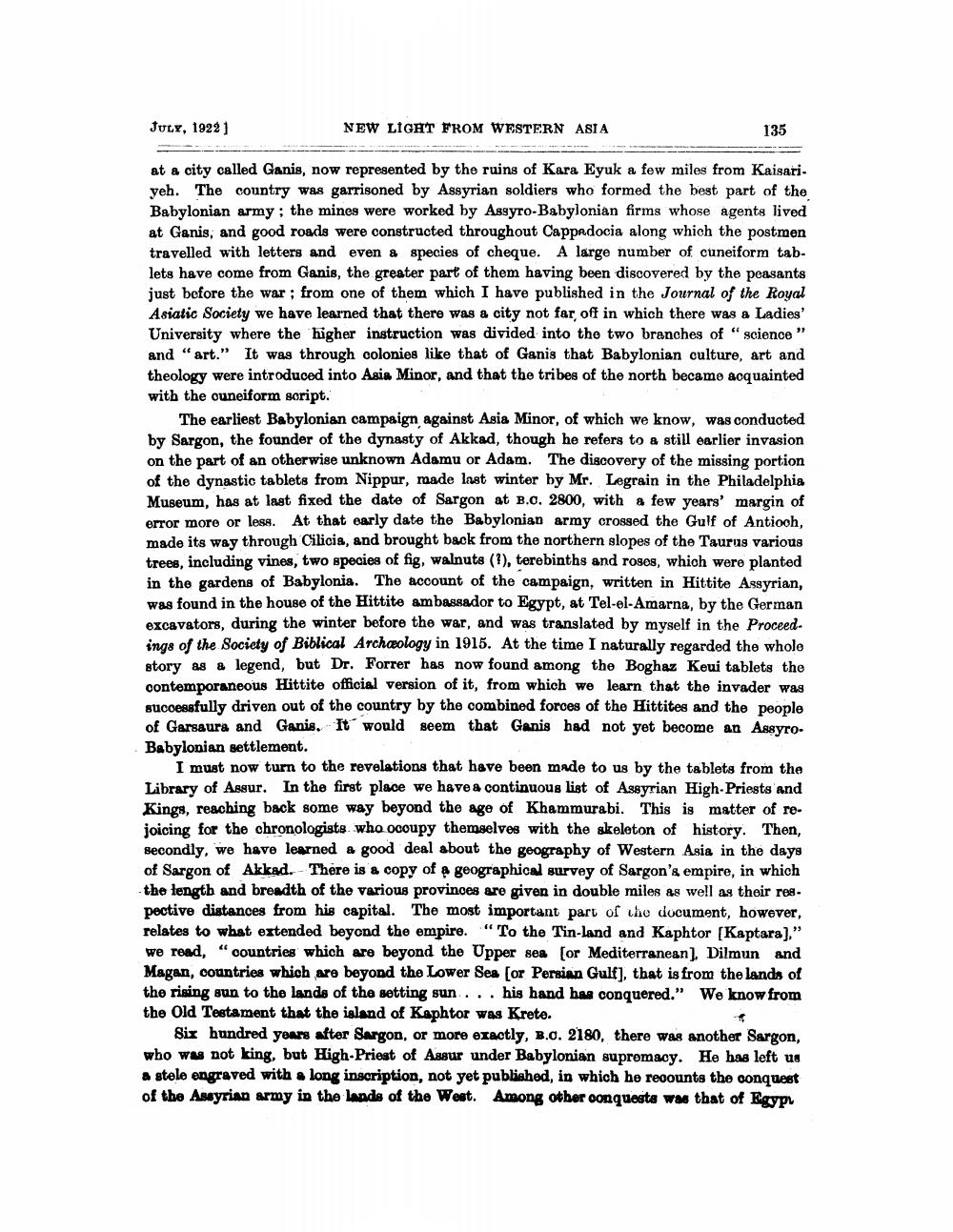________________
JULY, 19221
NEW LIGHT FROM WESTERN ASIA
135
at a city called Ganis, now represented by the ruins of Kara Eyuk a few miles from Kaisari. yeh. The country was garrisoned by Assyrian soldiers who formed the best part of the Babylonian army : the mines were worked by Assyro-Babylonian firms whose agents lived at Ganig, and good roads were constructed throughout Cappadocia along which the postmen travelled with letters and even a species of cheque. A large number of cuneiform tab. lets have come from Ganis, the greater part of them having been discovered by the peasants just before the war ; from one of them which I have published in the Journal of the Royal Asiatic Society we have learned that there was a city not far off in which there was a Ladies' University where the higher instruction was divided into the two branches of "science" and "art." It was through colonies like that of Ganis that Babylonian culture, art and theology were introduced into Asia Minor, and that the tribes of the north became acquainted with the ouneiform script.
The earliest Babylonian campaign against Asia Minor, of which we know, was conducted by Sargon, the founder of the dynasty of Akkad, though he refers to & still earlier invasion on the part of an otherwise unknown Adamu or Adam. The discovery of the missing portion of the dynastic tablets from Nippur, made last winter by Mr. Legrain in the Philadelphia Museum, has at last fixed the date of Sargon at B.O. 2800, with a few years' margin of error more or less. At that early date the Babylonian army crossed the Gulf of Antioch, made its way through Cilicia, and brought back from the northern slopes of the Taurus various trees, including vines, two species of fig, walnuts (?), terebinths and roses, which were planted in the gardens of Babylonia. The account of the campaign, written in Hittite Assyrian, was found in the house of the Hittite ambassador to Egypt, at Tel-el-Amarna, by the German excavators, during the winter before the war, and was translated by myself in the Proceedings of the Society of Biblical Archæology in 1915. At the time I naturally regarded the whole story as a legend, but Dr. Forrer has now found among the Boghaz Keui tablets the contemporaneous Hittite official version of it, from which we learn that the invader was successfully driven out of the country by the combined forces of the Hittites and the people of Garsaura and Ganis. It would seem that Ganis had not yet become an Assyro. Babylonian settlement.
I must now turn to the revelations that have been made to us by the tablets from the Library of Aggur. In the first place we have a continuous list of Assyrian High-Priests and Kings, reaching back some way beyond the age of Khammurabi. This is matter of rejoicing for the chronologists who ocoupy themselves with the skeleton of history. Then, secondly, we have learned a good deal about the geography of Western Asia in the days of Sargon of Akkad. There is a copy of geographical survey of Sargon's empire, in which the length and breadth of the various provinces are given in double miles as well as their res. pective distances from his capital. The most important part of the document, however, relates to what extended beyond the empire. "To the Tin-land and Kaphtor (Kaptara)." we read,"countries which are beyond the Upper sea for Mediterranean), Dilmun and Magan, countries which are beyond the Lower Sea (or Persian Gulf], that is from the lands of the rising sun to the lands of the setting sun... his hand has conquered." We know from the Old Testament that the island of Kaphtor was Krete.
Six hundred years after Sargon, or more exactly, B.C. 2180, there was another Sargon, who was not king, but High-Priest of Assur under Babylonian supremacy. He has left us a stelo engraved with a long inscription, not yet published, in which he recounts the conquest of the Assyrian army in the lands of the West. Among other conquesta was that of Egyp




